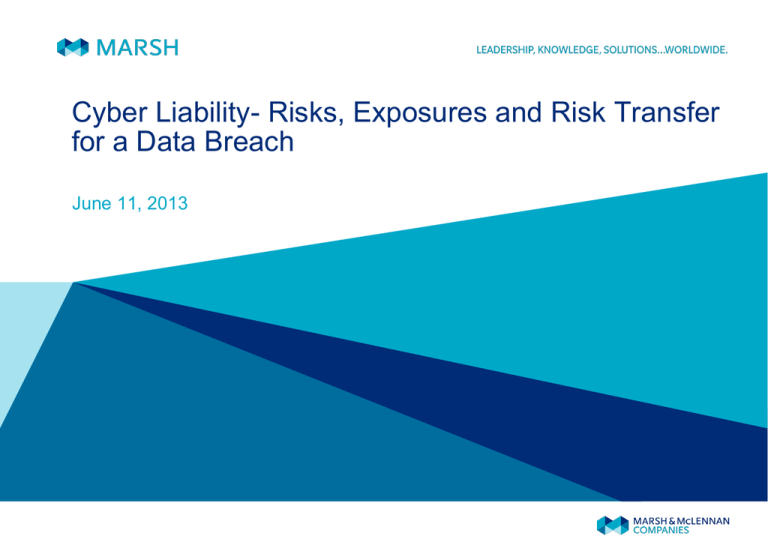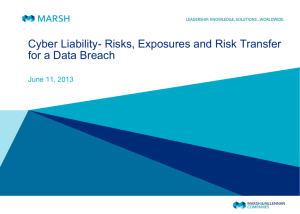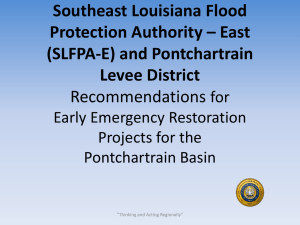Cyber Liability Insurance - American Public Transportation Association
advertisement

Cyber Liability- Risks, Exposures and Risk Transfer for a Data Breach June 11, 2013 What are Network Security/Privacy Risks? • Legal liability to others for computer security breaches • Legal liability to others for privacy breaches of confidential information • Costs to investigate and notify others of a breach • Regulatory actions, fines and scrutiny • Cyber-extortion • Cyber-terrorism • Electronic content • Loss or damage to data / information • Loss of revenue due to a computer attack • Extra expense to recover / respond to a computer attack • Loss or damage to reputation MARSH April 13, 2015 1 Threat and Regulatory Environment • Internal – Rogue employees – Careless staff • External – Business Associates/Vendors/ Suppliers – Organized crime • Foreign • Domestic – Hackers/Hacktivists MARSH • Technology – Viruses, SQL Injections, etc… – Structural vulnerability – Social Media/Networking – Phishing • Old school – Laptop theft – Dumpster diving • Regulatory – HIPAA, HITECH, Red Flags – FTC, HHS, state attorney generals – 47 State Breach notification laws – Foreign Laws: Canada, South Korea, Spain – DHS/NIST developing Cyber Framework – EU Parliament has introduced its General Data Protection Regulation April 13, 2015 2 What types of information is at Risk Many people think that without credit cards or PHI, they don’t have a data breach risk. But can you think of any business without any of the below kinds of information? Consumer Information • Credit Cards, Debit Cards, and other payment information • Social Security Numbers, ITIN’s, and other taxpayer records • Customer Transaction Information, like order history, account numbers, etc. • Protected Healthcare Information (PHI), including medical records, test results, appointment history • Personally Identifiable Information (PII), like Drivers License and Passport details • Financial information, like account balances, loan history, and credit reports • Non-PII, like email addresses, phone lists, and home address that may not be independently sensitive, but may be more sensitive with one or more of the above Employee Information • Employers have at least some of the above information on all of their employees Business Partners • Vendors and business partners may provide some of the above information, particularly for Sub-contractors and Independent Contractors • All of the above types of information may also be received from commercial clients as a part of commercial transactions or services • In addition, B2B exposures like projections, forecasts, M&A activity, attorney- client communication, litigation strategy and trade secrets MARSH April 13, 2015 3 Threat Environment- Targets of Opportunity Verizon Security Consultants 2013 Data Breach Investigations Report A sample of 47,000 reported incidents with 621 confirmed breaches. Some key findings: – 78% were not highly difficult involving little to no resources or customization of software. – 75% were not targeted at a specific individual or company – 76% of network intrusions exploited weak or stolen credentials – 29% of attacks utilized social tactics (email, phone calls, or social network information) – 14% of attacks involved insiders; 50% of those were former employees using old credentials – 2/3rds of breaches involved data at rest (databases and file servers). The remaining amount was compromised at the time processed. – 66% of breaches took months (62%) or years (4%) to discover – 69% of breaches were discovered by an external party (9% by customers) Industries groups represented by percent of breaches (total exceeds 100% due to rounding): – 37% from Finance and Insurance – 24% from Retailers – 20% from Manufacturers, transportation and utility – 20% Information and professional service firms MARSH April 13, 2015 4 Simplified Data Breach Timeline Actual or alleged theft, loss, or unauthorized collection/disclosure of confidential information that is in the care, custody or control of the Insured, or a 3 rd for whom the Insured is legally liable. Discovery can come about several ways: Discovery •Self discovery: usually the best case •Customer inquiry or vendor discovery •Call from regulator or law enforcement Forensic Investigation and Legal Review First Response External Issues Long-Term Consequence s MARSH •Forensic tells you what happened •Legal sets out options/obligations Public Relations Income Loss Notification Damage to Brand or Reputation April 13, 2015 Remedial Service Offering Regulatory Fines, Penalties, and Consumer Redress Civil Litigation 5 What would a Breach Cost? Number of Records Compromised 100,000 500,000 1,000,000 Number of Credit Card Numbers Compromised 100,000 500,000 1,000,000 Forensics, Legal & Advisory Costs $100,000 $100,000 $250,000 Notification Costs $200,000 $1,000,000 $1,000,000 Call Center Costs $100,000 $500,000 $1,000,000 Credit Monitoring Costs $300,000 $1,500,000 $2,250,000 Identity Theft Repair Costs $500,000 $2,500,000 $5,000,000 Estimated First Party Costs $1,200,000 $5,600,000 $9,500,000 Credit Card Reissuance Costs $600,000 $3,000,000 $6,000,000 Consumer Redress Fund & Fines $600,000 $3,000,000 $6,000,000 Other Liability $500,000 $2,500,000 $5,000,000 Defense Costs $100,000 $500,000 $1,000,000 Estimated Third Party Liability (Inc. defense) $1,800,000 $9,000,000 $18,000,000 Estimated Privacy Event Insurable Cost $3,000,000 $14,600,000 $27,500,000 Assumptions Per record notification cost $2.00 $2.00 $1.00 20% 20% 20% $5.00 $5.00 $5.00 15% 15% 15% $20.00 $20.00 $15.00 5% 5% 5% $500.00 $500.00 $500.00 Credit card reissuance cost per card $6.00 $6.00 $6.00 Consumer Redress & Fines per record $6.00 $6.00 $6.00 Other liability experience rate 1% 1% 1% Other liability cost per record $500.00 $500.00 $500.00 Call center participation rate Per call cost Credit monitoring participation rate Credit monitoring per record cost Identity theft rate of occurrence Identity theft per record cost Regulatory Actions usually precedes the civil action, substantial expense-legal and forensic can be incurred even for events where no one MARSH 6 April 13, is actually harmed or2015 even at risk of harm Network Security/Cyber Coverage Overview • Privacy Liability: Harm suffered by others due to the collection or disclosure of confidential information. • Network Security Liability: Harm suffered by others from a failure of your network security • Cyber-Extortion: The cost of investigation and the extortion demand (limited cover for ransom & crisis consultant expenses) • Regulatory Defense: Legal counsel for regulatory actions including coverage for fines and penalties where permissible • Event/Breach Costs: The costs of complying with the various breach notification laws and regulations including legal expense, call centers, credit monitoring and forensic investigation. • Data Property: The value of data stolen, destroyed, or corrupted by a computer attack • Business Interruption: Business income that is interrupted by a computer attack or a failure of technology including the extra expense. Coverage for Privacy Liability requires no negligence on the part of the insured and provides coverage for the intentional acts of insured’s employees MARSH April 13, 2015 7 Information Risk Insurance Marketplace • Robust market with $350MM of market capacity for liability (third party) • $200MM for Business Interruption (first party) – Appetite varies by coverage triggers and industry – Concern about risk aggregation associated with cloud computing – Limited appetite for full Contingent Business Interruption • Increase in loss activity • Recent Innovations – Turnkey breach management approach – Pre-loss control services MARSH April 13, 2015 8 Carrier approach • Currently there are two approaches in the market: – Providing a dollar sublimit • Pros: - Insured maintains control of the process - Insured knows exactly how much money they have available for an “event” - Can be outside the limit of liability • Cons: - Insurer may not agree to all costs incurred - Insurer may not approve insured’s selected vendors - Dollar sublimit may not be sufficient to respond to all costs associated with an “event” – Providing a per person sublimit. • Pros: - Typically outside the aggregate limit of liability - Insured selects response firm from a panel counsel list - the response is handled by the insurer • Cons: - The Insured hands over the response to the insurer’s vendors - Larger clients, the per person sublimit removes control which they expect to maintain - Typically only offered to companies with <$4B in revenue MARSH April 13, 2015 9 Marsh This document and any recommendations, analysis, or advice provided by Marsh (collectively, the “Marsh Analysis”) are intended solely for the entity identified as the recipient herein (“you”). This document contains proprietary, confidential information of Marsh and may not be shared with any third party, including other insurance producers, without Marsh’s prior written consent. Any statements concerning actuarial, tax, accounting, or legal matters are based solely on our experience as insurance brokers and risk consultants and are not to be relied upon as actuarial, accounting, tax, or legal advice, for which you should consult your own professional advisors. Any modeling, analytics, or projections are subject to inherent uncertainty, and the Marsh Analysis could be materially affected if any underlying assumptions, conditions, information, or factors are inaccurate or incomplete or should change. The information contained herein is based on sources we believe reliable, but we make no representation or warranty as to its accuracy. Except as may be set forth in an agreement between you and Marsh, Marsh shall have no obligation to update the Marsh Analysis and shall have no liability to you or any other party with regard to the Marsh Analysis or to any services provided by a third party to you or Marsh. Marsh makes no representation or warranty concerning the application of policy wordings or the financial condition or solvency of insurers or reinsurers. Marsh makes no assurances regarding the availability, cost, or terms of insurance coverage. MARSH April 13, 2015 10











